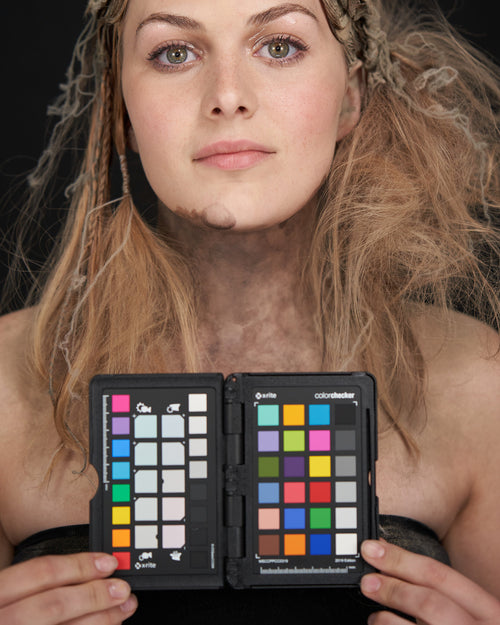Color Temperature / Kelvin Measurements
Why does this matter to a makeup artist?
Color temperature refers to the warmth or coolness of light, measured in Kelvin (K). The Kelvin Scale is a measurement system used to describe the color temperature of light sources. In the visible light range, it starts at absolute zero and measures how light shifts from warm to cool tones as the temperature value increases.

White light on the Kelvin scale typically falls between 5000K and 5500K. This range is considered “neutral” or “daylight” white, a full-spectrum balance of warm and cool tones. It is often referred to as pure white light, similar to midday sunlight. It’s the most accurate for revealing true colors, making it ideal for makeup application, photography, and other tasks requiring color precision. A light source of 100 CRI, or perfect CRI, will give an object under it the appearance as if it were bathed in natural direct sunlight.

Now that we understand color temperature/ Kelvin, its relation to CRI (Color Rendering Index), and how crucial it is for accurately seeing colors, it’s important to recognize that your eye relies on the color in light to perceive the world correctly. This is the color theory of light. Kelvin temperature acts like a hue that colors the subject or scene, affecting how we see skin tones, makeup, and objects. Warmer Kelvin values add a yellowish hue, while cooler ones introduce a blue cast, each impacting how true-to-life or flattering the colors appear. Therefore, choosing a neutral white color temp (around 5200K) with a high CRI (97+) is critical for your eye to see the colors correctly.
Now Let’s Talk About White Balance—and Why It Changes Everything

Color temperature might be simple, but white balancing is where things get tricky. And understanding how your eyes and the camera handle light differently is key.
Your eyes are smart—but not always accurate.
They automatically adapt to different lighting without you realizing it. Your brain tells you the shirt is white whether you’re in candlelight, sunlight, or standing under a streetlamp. Your brain is constantly “white balancing” what you see so the world looks consistent. That’s useful for everyday life, but not great when you’re making delicate color decisions on skin.
Now enter the camera.
The camera also white balances—but it does it in a completely different way. Whether it’s a professional cinema camera or an iPhone, it adjusts the color to make white look white based on the light it’s working with. If you’re filming under 3200K tungsten light, the camera will neutralize that warm tone to get a balanced image.
Here’s where the problem comes in:
If you apply makeup under that same 3200K warm light, your eye adapts to the warmth. You don’t see how much yellow-orange is washing over the face. So you makedecisions based on a distorted view—maybe overcorrecting, or choosing a foundation that seems right but reads completely wrong once the camera white balances.
THIS PHOTO SAYS IT ALL

Let’s take a look at what’s really happening here. (the camera in constant-balanced for daylight - it is NOT on “auto white balance”)
The first photo, 5200K is white light, that’s full-spectrum and high CRI. It reveals skin tone, texture, and the makeup swatches as they truly are.
Every other photo is lit with a different color temperature —warmer and cooler. And just look at what happens as the color temperature changes.
The exact same makeup now looks different.
This is what color temperature does. It doesn’t change the makeup—but it absolutely changes what you think you see.
Even worse, you can’t tell by looking if the light you’re using has a high CRI. You need a spectrometer for that. You might think you’re seeing clearly—but the light could be dropping wavelengths your eye needs to judge color accurately. The camera? It sees those gaps right away.
So, What Should You Do?
Make your makeup decisions in neutral, full-spectrum, high-CRI light—around 5200K. That’s your truth light. The color temp is white, and the high CRI ensures all colors appear as equal under daylight. That’s where you match foundation, correct discoloration, balance undertones, and assess texture. That’s the light you trust, and that is TML lighting.




